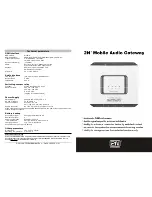
QX5
QXFXO4/QXISDN4/QXE1T1/QXFXS24; (SW Version 6.0.x)
46
QXFXO4/QXISDN4/QXE1T1/QXFXS24 Manual II: Administrator’s Guide
The fields in the
MSN Number
column require the MSN numbers
allocated to the QX.
Please Note:
At least one MSN number should be defined in this
page. The system displays an error message if the same MSN
number is used twice in this page.
The
Route Incoming Call to
drop-down lists is used to select the
destination where the incoming call addressed to the certain MSN
number will be routed. Choosing the
Routing with inbound
destination number
selection will automatically use the initially
dialed number to connect the destination without any additional
dialing. If MSN is disabled on the
ISDN Wizard -
MSN Settings
page, the
ISDN Wizard -
Routing Settings
page contains only one
Route Incoming Call to
drop-down list.
Selecting the
Use Default outgoing Caller ID
allows you to
overwrite the source caller information with the one specified in
the
Default outgoing Caller ID
field when placing outgoing calls
toward the CO. The
Default outgoing Caller ID
field requires the
caller ID for the outgoing calls from the QX through the ISDN trunk.
That number should be registered at the CO and can be one of the
MSNs provided by the CO. If this checkbox is enabled but no value
is defined in the
Default outgoing Caller ID
, empty caller
information will be sent to the CO. If this checkbox is disabled, the
source caller information will be forwarded to the CO.
Fig.II- 57: ISDN Wizard – Routing Settings page
Select the
Advanced Settings
checkbox if you wish to adjust trunk’s L2 and L3 Settings manually, otherwise leave this checkbox unselected to use the
system default values.
The
ISDN Wizard
–
L2&L3 Settings
is used for advanced configuration only and contains L2&L3 Settings. This page only appears when the
Advanced
Settings
checkbox is selected on the previous page of the wizard. This page contains the following components:
ISDN L2 Timers:
•
Excessive Ack. Delay T200
configures the period in milliseconds (numeric values from 500 to 9999) between the transmitted signaling packet and
its acknowledgement received.
•
Idle Timer
T203
configures the period in milliseconds (numeric values from 1000 to 99999) for the ISDN client idle timeout.
















































